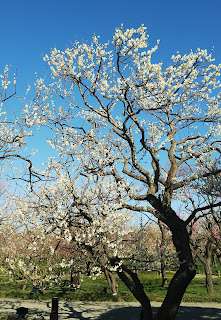This is Ieda, a staff member of the Suzuki Herb Laboratory, and I went to Kairakuen to see the plum blossoms on March 3. Here is my report on the visit.
Kairakuen, located in Mito City, Ibaraki Prefecture, is known as one of the three most famous gardens in Japan and is famous for its many varieties of plum trees that bloom in February and March.
Kairakuen is located in Mito, which is the third train ride (about 20 minutes) from Tokai-mura, where we are located at Suzuki Herb Laboratory.
Mito is a castle town with a long history. I took a short trip to Kairakuen. It was the day after it had just rained, and I was worried that the flowers might have fallen off, but the plum blossoms were almost in full bloom, and the blue sky made for a beautiful sight.
There are around 3,000 plum trees in 100 varieties. The plum trees are red, white, dark pink, light pink, and many other colors in harmony, and their branches are of various shapes and sizes, so you can enjoy a leisurely stroll without getting bored. The beauty of the flowers is different from that of cherry blossoms, and it seems to cleanse your mind as you look at them.
From time to time, I could feel a faint fragrance along with the wind. (I wished I could taste it without a mask!)
Kairakuen is located on a small hill, overlooking Senba Lake. Lake Senba is a symbol of Mito and a place of recreation for the local residents.
When I looked down from Kairakuen toward Senba Lake, I could see a series of plum trees on the slope of the hill and on the plain by the lake below, and the scenery was incomparably beautiful.
In Japanese gardens, a technique called "borrowed scenery" is used, in which the surrounding landscape is incorporated into the design of the garden as part of the view. In the case of Kairakuen, the scenery of the entire Senba Lake area is incorporated as a borrowed landscape.
I entered the "Kibuntei", a building in the Kairakuen garden. There is a corridor around the room. The corridor felt cool. Kobun-tei consists of a room for the wife to rest, a room for guests, a banquet hall, a tea ceremony room, and an anteroom. It has a simple but elegant atmosphere. The view from the second floor is breathtaking.
History of Kairakuen
The Kairakuen Garden was built in 1842 by the ninth lord of the Mito domain, Nariaki Tokugawa. After becoming the feudal lord at the age of 30, he immediately undertook a variety of reforms, including thoroughgoing thrift and reform of the military system. Among the various policies that were later called the Tenpo Reforms of the Mito Clan, the construction of the clan school Koudoukan and the creation of Kairakuen were the most important.
The Koudoukan was a school for the clan's warriors to study academics and martial arts throughout their lives.
After studying and practicing martial arts at the Koudoukan, he wanted them to rest and rejuvenate their minds and bodies, so he established Kairakuen as a pair of educational facilities.
In " Kairakuenki," which describes the purpose of the garden, there is an inscription that reads, "It is my intention to share the enjoyment with the people," indicating that the garden was intended to be open not only to the clansmen but also to the common people of the domain. Furthermore, on the back side of the stone monument of "Kairakuenki" in the garden, six rules for entering the garden are inscribed as "Forbidden Articles," indicating that the garden was similar to a modern park with rules for public use.
Kairakuen and plum blossoms
A stone monument in Kairakuen contains the words of Nariaki.
Here I have planted several thousand plum trees to mark the beginning of spring. (From the Kairakuen monument)
Plum blossoms bloom in early spring, ahead of cherry blossoms. By planting thousands of plum trees, the garden was made a place where spring would come first. They also used the fruit of the plum trees as food for their troops in case of emergency.
As I walked among the plum trees, I was reminded of the time when Prince Nariaki lived. I wondered what the warriors of the Mito clan and the common people who visited there must have felt among the blooming plum blossoms.







Comments
Post a Comment